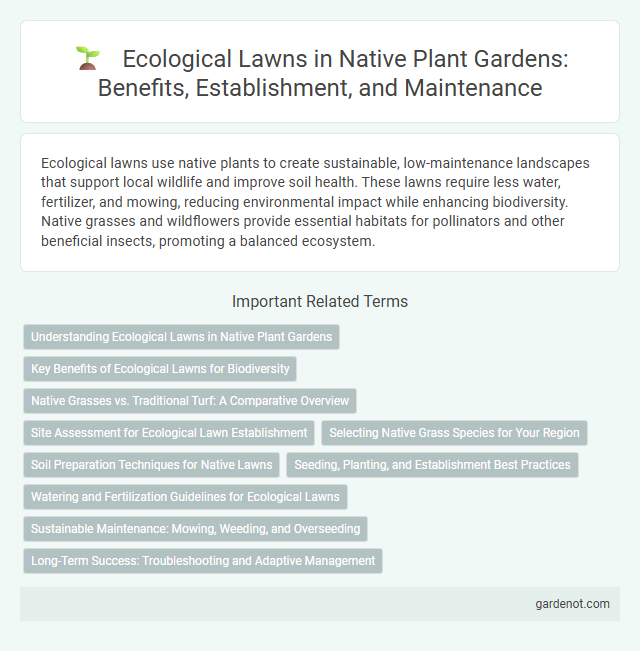Ecological lawns use native plants to create sustainable, low-maintenance landscapes that support local wildlife and improve soil health. These lawns require less water, fertilizer, and mowing, reducing environmental impact while enhancing biodiversity. Native grasses and wildflowers provide essential habitats for pollinators and other beneficial insects, promoting a balanced ecosystem.
Understanding Ecological Lawns in Native Plant Gardens
Ecological lawns in native plant gardens utilize drought-tolerant, low-maintenance native grasses and groundcovers that support local biodiversity and reduce water usage. These lawns promote soil health by enhancing microbial activity and minimizing the need for synthetic fertilizers or pesticides. Incorporating native species such as buffalo grass (Bouteloua dactyloides) and white clover (Trifolium repens) fosters habitat for pollinators and beneficial insects, contributing to a sustainable garden ecosystem.
Key Benefits of Ecological Lawns for Biodiversity
Ecological lawns support biodiversity by providing habitat for native insects, birds, and pollinators essential to healthy ecosystems. These lawns reduce the need for chemical fertilizers and pesticides, promoting soil health and protecting surrounding waterways from contamination. Native grasses and wildflowers in ecological lawns enhance resilience to drought and pests, ensuring sustainable green spaces that foster diverse biological communities.
Native Grasses vs. Traditional Turf: A Comparative Overview
Native grasses in ecological lawns offer superior drought tolerance and reduced maintenance compared to traditional turf varieties, promoting biodiversity and supporting local wildlife habitats. Traditional turf requires higher water inputs and frequent mowing, leading to increased environmental impact and resource consumption. Integrating native grasses enhances soil health and resilience, making ecological lawns a sustainable alternative to conventional lawns.
Site Assessment for Ecological Lawn Establishment
Site assessment for ecological lawn establishment involves analyzing soil composition, drainage patterns, and native vegetation to ensure optimal plant health and sustainability. Evaluating sunlight exposure and microclimate conditions helps select appropriate native grass species that thrive with minimal irrigation and chemical inputs. Incorporating site-specific assessments reduces maintenance requirements and promotes biodiversity within the lawn ecosystem.
Selecting Native Grass Species for Your Region
Selecting native grass species adapted to your region's climate and soil conditions ensures a sustainable ecological lawn that requires less water and maintenance. Native grasses such as Buffalo grass in the Midwest, Blue Grama in the Southwest, and Fine Fescue in the Northeast provide excellent ground cover while supporting local biodiversity. Incorporating these region-specific species promotes healthy ecosystems, reduces chemical inputs, and enhances soil health over time.
Soil Preparation Techniques for Native Lawns
Effective soil preparation techniques for ecological lawns emphasize enhancing soil structure and nutrient availability to support native plant growth. Incorporating organic matter such as compost improves soil fertility and moisture retention, promoting robust root development. Minimal tilling preserves soil microorganisms essential for nutrient cycling, ensuring a resilient native lawn ecosystem.
Seeding, Planting, and Establishment Best Practices
Seeding an ecological lawn requires selecting native grass species adapted to local soil and climate conditions to enhance biodiversity and reduce maintenance. Proper soil preparation, including aeration and removal of weeds, ensures optimal seed-soil contact for successful germination. Establishment best practices involve consistent watering, minimal foot traffic, and gradual mowing to encourage deep root development and resilient turf growth.
Watering and Fertilization Guidelines for Ecological Lawns
Ecological lawns require minimal watering, relying primarily on natural rainfall to maintain soil moisture and support native plant resilience, thereby reducing water consumption by up to 50% compared to traditional lawns. Fertilization is seldom necessary, but when applied, organic or slow-release fertilizers rich in nitrogen, phosphorus, and potassium help promote healthy root growth while minimizing nutrient runoff and environmental impact. Implementing proper watering schedules, such as deep watering during early morning hours, enhances drought tolerance and encourages deep root systems critical for sustainable ecological lawn maintenance.
Sustainable Maintenance: Mowing, Weeding, and Overseeding
Sustainable maintenance of an ecological lawn involves mowing at higher heights to promote deep root growth and reduce water evaporation, aligning with native plant growth cycles. Weeding should prioritize manual removal or targeted treatments to protect beneficial native species and maintain biodiversity. Overseeding with native grass varieties enhances resilience, supports local wildlife habitats, and prevents invasive species from establishing.
Long-Term Success: Troubleshooting and Adaptive Management
Ecological lawns thrive through adaptive management practices that respond to changing environmental conditions and plant health. Troubleshooting common issues such as invasive species, soil compaction, and uneven growth ensures sustainable plant communities and resilient turf. Long-term success depends on regular monitoring, soil testing, and adjusting maintenance techniques to support native species diversity and ecosystem balance.
Ecological lawn Infographic

 gardenot.com
gardenot.com